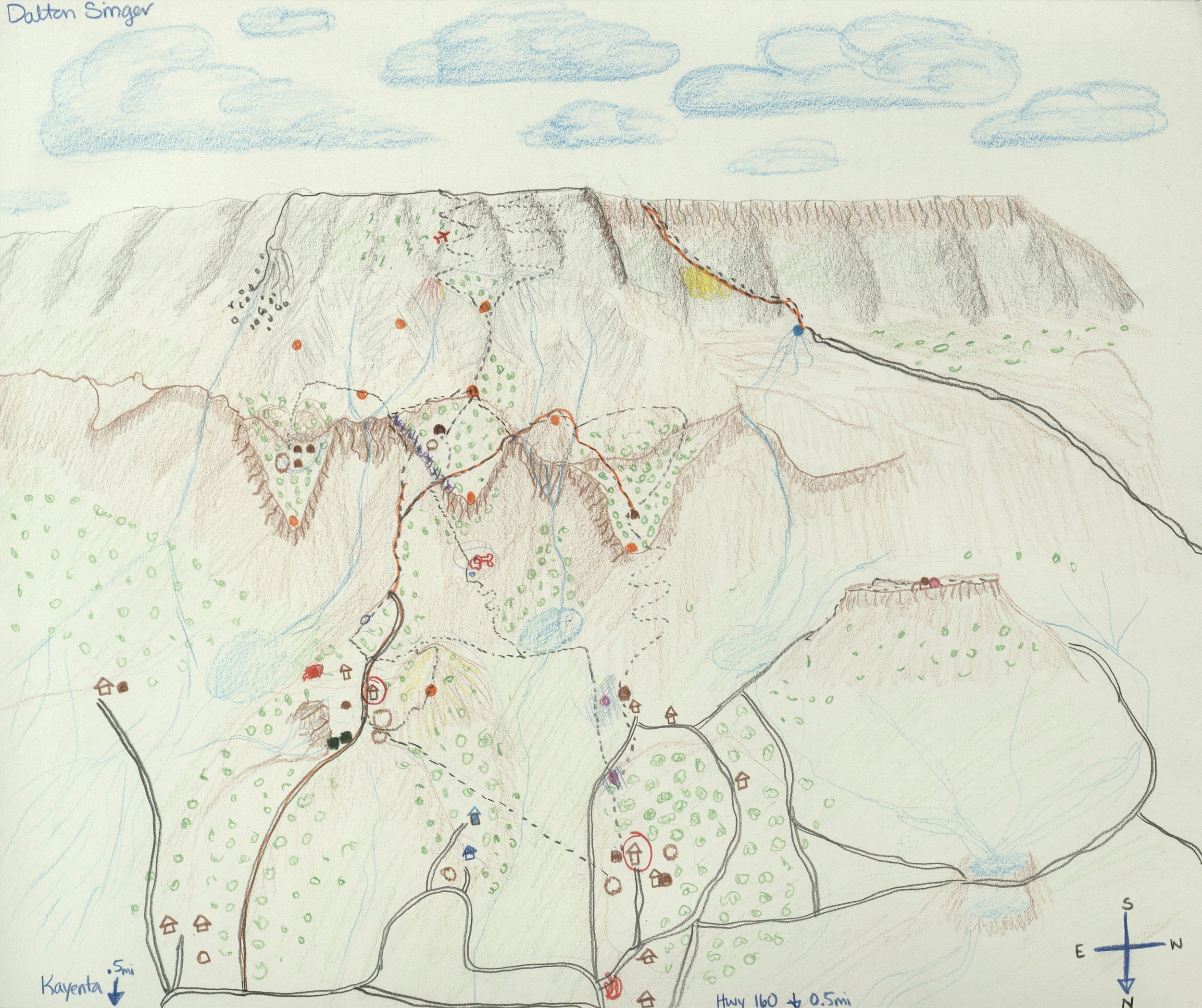
Walking With Dinétah is a community art and trail walking initiative dedicated to co-creating strategies for cultural resilience and healing through spatialized oral histories, memory work, mapmaking, and participatory art—in other words, through Hózhó náhásdlíí’, or “walking in beauty.”
WALK the trails
Explore a living spatialized community archive of meaningful places, important stories, local knowledge, and walking trails on ArcGIS
ARCHIVE OF HAND DRAWN MAPS
Browse hand drawn maps from our community mapping workshop and listen to stories with elders, youth, and community leaders
STORYMAPS
Coming Soon: Immerse yourself in Chilchinbeto, Kayenta, and Dennehotso through place-based storytelling
ABOUT WALKING WITH Dinétah
Our monument is already made.
Dinétah, “among the people,” is the ancestral land of the Diné. It is marked by four sacred mountains in the modern day Four Corners area and is embedded with intergenerational knowledge. Walking With Dinétah is a Nááts'íilid Initiative project that co-creates a living digital archive in the form of a regional map through collecting narratives from elders, and asset mapping with residents of Chilchinbeto, Kayenta, and Dennehotso. Our research identifies, maps, and marks Indigenous trails in Dennehotso, Chilchinbeto, and Kayenta through embedding digitally recorded knowledge, place-based Indigenous art, mnemonic installations, and local vegetation that will attract wildlife.
Our goal is to shift the narratives with which places in Chilchinbeto are currently consumed by tourists and overlooked by Navajo youth. The aesthetic gaze of the modern tourist silences the ancestral red rock mesas and wind chiseled canyons in the region to merely “sublime desolation,” and pristine, uninhabited “wilderness.” European romanticism actively erases Indigenous history and replicates colonial patterns that justified The Long Walk forced upon the Navajo. Its reductiveness is reinforced by the delegitimization of Indigenous values and ethics and the destruction of mnemonic systems through which skills and belonging have been traditionally passed from elders to younger generations. Tourism and modern education have institutionalized a vision of Indigenous land as land without people and people without a history, science, and meaningful knowledge.
Walking with Dinétah will reveal Chilchinbeto, Dennehotso, and Kayenta—and indeed all Indigenous places—not as empty, but, as elders say, “already made,” reconnecting Diné youth with traditional ways and revitalizing their pride.
The evolving regional plan reestablishes continuity between the placemaking strategies of basket makers, ancestral Puebolans, and Diné. Original storytelling and art made in its reflection emphasize the land as an ecosystem and a place, and not as an abstract space. The ecosystem will continue to host humans among yucca, Indian rice grass, spiny lizards, and ferruginous hawks.
Our map also serves as a tool of empowerment, giving power back to localities to control their narratives and shifting public consciousness to push reparations-driven planning and policy. The goal of the digital interface is to encourage conversations on Indigenous ways of knowing, holding a mirror to the knowledge economy of settler-colonialism and creating a connection between Indigenous people and diasporic communities who share the historical trauma of colonization.
Walking will involve both literal and figurative walking in which the land speaks to the interlocutor. For the Diné, walking with the land means listening, feeling, and resting as opposed to disembodied contemplation that should restore our intergenerational trust, memory work, cultural reclamation, and investment in communal practices. It will allow us to know the three chapters as places of ephemera like stories, dances, and music.
Acknowledgements
Monument Lab Team: Tonia Sing Chi, Samantha Eddy, Kassie John, and Shundana Yusaf
Partners: CarmiRae Holguin, Renae Hoshnic, Dalton Singer, Nathaniel Brown, and Eugene Badonie
Supported by: Monument Lab Re:Generation Grant and the Mellon Foundation




